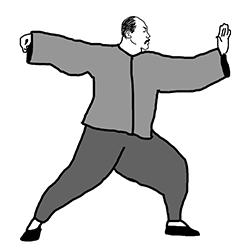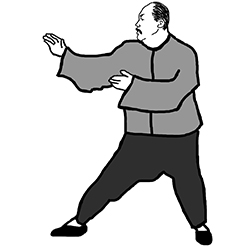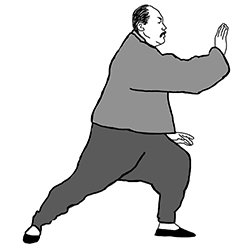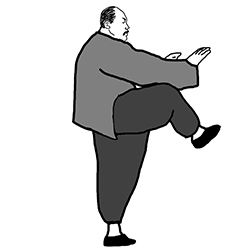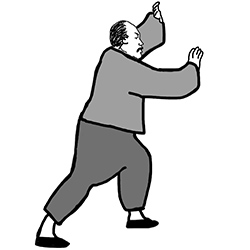
Choreographed Forms
Meticulous consideration has been given so that each new movement develops a new skill.
The Genius of Taijiquan
Taijiquan originates with Taoism's observations of nature's laws. These laws include the forces described in physics such as gravity, mass, force, and energy. The laws also include the properties of water and fire. The laws access methods for spiritual, mental and physical development. In addition, the Taoist also understand ways to access deeper layers of awareness, and with the knowledge that comes from that awareness how to gain freedom from the hampering stresses of daily living.
Part of the genius of the Yang Family Long Taijiquan form is how each new move in the sequence helps develop a new physical skill. At the outset of learning, the skills may seem so ordinary—even mundane—that it is easy to miss the subtlety and importance of how to properly perform each movement. Take the simple example of lifting your arms. Normally this movement is completely second nature. Without training, the normal way is to lift your arms by contracting the deltoid muscles of the shoulders. However, in Taijiquan you are instructed to drop (relax) your shoulders. When you can do this while lifting your arms the deeper muscles of the scapula and spine participate in raising your arms.
Taijiquan training teaches you how to move with all the parts of the body participating appropriately. You can liken the Taijiquan way of moving to the way a Swiss watch works. All the gears must turn for the watch to tell time. Each of the gears turns at its own rate so that the second hand moves at a different pace than the minute and hour hands yet all work together in harmony. This is what is meant by "when one part moves, all the parts move."
The Method for Acquiring Skills
The fastest way to gain the skills in Taijiquan is by what appears to be slow, smooth movements. As is often the case, the methods of Taijiquan turn out to be counter-intuitive. Although the practice takes you to a more natural way of moving, it is paradoxically in opposition to the normal way of human movement. You are asked to use your mind at every moment. At the same time, you are to maintain as state of dynamic relaxation, which is not the way movement typically happens.
Movement can begin one of two ways. Typically, you move your body by tensing the muscles necessary to do the job. In Taijiquan, movement begins by releasing the accrued tension that precedes the movement. Since most tension is slight, until you're properly attuned to being aware of the subtler sensations of tension, you may not even realize how much tension is carried in your body.
You can see from the images of Yang Chengfu on this page, the postures are dynamic and not without effort. However, the effort required is the minimum necessary to maintain the alignment as well as to move from position to position in a flowing manner from start to finish.
Minimum Effort, Maximum Efficiency
Taijiquan’s first and foremost teaching is to stand on our own two feet. This task we learned in our first year of life, is still daunting. Even though we’re able to keep from falling, we do so through many subtle machinations. What we learn in Taijiquan is how to stand properly. We emphasize maintaining structural strength with the least amount of effort. It is the skeletal system that is designed to bear body weight. When properly aligned, the muscles need not to strain to keep the body erect. Instead, the muscles have only to sustain the alignment. Greater relaxation without a loss of strength is the result.
A Unique Way of Moving
Taiji is an exercise for the joints. It emphasizes exercising tendons, ligaments and the connective tissues of the body as opposed to the muscles. Muscles are used, but motion is produced while sustaining their relaxation. In part, this is accomplished by confining movements to their most comfortable range.
Tendons and ligaments are used to retain the body’s natural shape so that the muscles can remain without tension. Postures are designed so that muscles are never over-stretched, and at the same time, are prevented from becoming too loose. Moving slowly allows the focus to remain clearly on subtle sensations, so that movements can be done optimally.
A Unified Body
In Taijiquan, the body works as a single integrated unit. All the power begins in the feet and moves progressively through the body until it is expressed in the hands. As a consequence, the power created in movement is much greater than it would otherwise be. For instance, instead of being pushed by a finger, the hand pushes the finger; the arm pushes the hand; the torso pushes the arm; the legs push the torso.
The Work of the Mind
The mental component of Taijiquan is the most important. It sharpens the mental faculties. It goes much further than just body awareness. Everything begins in the mind. Nothing is ever accomplished in the human realm unless it manifests first in the mind.
Linking the mind with the body is part of the foundation work of Taijiquan. Most of us have only partial awareness of our bodies. There are areas where we may be blind to any but intense sensations. In Taijiquan, we direct our attention into all the parts of our bodies. In some places, we may have to rely upon our imagination to visualize. When we practice, we endeavor to link our thoughts (the conscious mind) with the sensations of the body (the subconscious mind). Learning the movements and coordinating the body provide tremendous mental exercise. Taijiquan helps keep mental acuity sharp.
